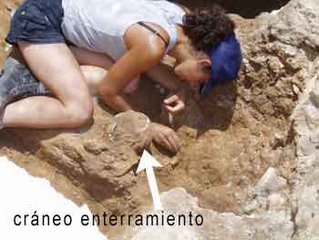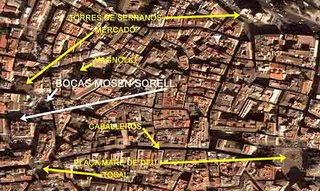Typical dishes
Among the multitude of recipes that make up the varied cuisines of Spain, a few can be considered common to all or almost all of Spain's regions, even though some of them have an origin known and associated with specific places. Examples include the potato omelette ("tortilla de patata"), gazpacho, paella, stews, migas, sausages (such as embutidos, chorizo, and morcilla), jamón serrano, and cheeses. There are also many dishes based on beans (chickpeas, lentils, green beans); soups, with many regional variations; and bread, that has numerous forms, with distinct varieties in each region. The regional variations are less pronounced in Spanish desserts and cakes: flan, custard, rice pudding (arroz con leche), torrijas, churros, and madeleines are some of the most representative examples. Others include:
Arroz a la Cubana
Cocido (a chickpea and meat stew of sorts)
Chorizo (spicy sausage)
Chuletillas (grilled chops of milk-fed lamb)
Gazpacho (cold bread and tomato soup)
Fabada Asturiana (bean stew)
Jamón serrano (cured ham)
Lechazo asado (roasted milk-fed lamb)
Mariscos (shellfish)
Paella (saffron rice)
Pescaito Frito, marinated battered fried fish, typical from Malaga and Western Andalusia
Tortilla de patatas or tortilla española (egg omelette with potatoes)
Turrón, a dessert with almonds and honey, typical of Christmas
Tortas de Aceite from Seville, a sweet Olive Oil pastry
Calamari (Fried Squid)
COCIDO
How to do it
First of all, wash all the meats and soupbone with hot water.
Put all the meats in a pot of boiling water and let come back to a hard boil.
Skim off the unsavory foam. Turn the heat down so the pot just simmers.
Continue to skim off the foam until there is none.
After 3/4 hour add the soaked chickpeas, which have been just rinsed with hot water.
Simmer for about 3 hours or until the garbanzos are tender.
This will vary according to the age of the garbanzos and it is impossible to tell that until they are cooked. About 1 hour before the end add the ppotatoes. Remove the soupbone, leaving the marrow in the stew. Add the salt.
To make the sauce, simmer together all the ingredients until thickened and saucelike, at least 3/4 to 1 hour. Strain and serve separately.
Note: In Spain, as elsewhere, the ingredients of a cocido, or stew, vary from family to family and depend much upon the tastes, finances, and even the whim of the individual cook. Julio de Diego, who likes to cook as much as he likes to paint, says that this is a good, everyday version.
F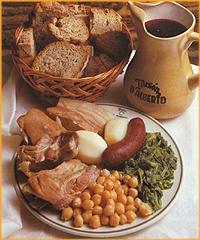 or occasions when one wishes to be more lavish add uncooked him in one piece, a blood sausage (available in groceries selling foreign foods and not half so revolting as it sounds to the squeamish), and half a chicken.
or occasions when one wishes to be more lavish add uncooked him in one piece, a blood sausage (available in groceries selling foreign foods and not half so revolting as it sounds to the squeamish), and half a chicken.
The proper servish of this dish is very impressive. First the broth, strained from the stew and flavored with saffron, is served with a spoonful of cooked rice in each bowl and garnished with croutons fried in olive oil.
The second course consists of the garbanzos drained from the stew, accompanied by a vegetable (coooked separately) such as string beans, cabbage, or spinache dressed with hot olive oil flavored with garlic. (The garlic clove is heated in the oil and discarded before pouring on the vegetable.) As the last and most important course, all the meats are arranged decoratively on a platter, the chicken in the center surrounded by the cut-up pieces of meat.
A bowl or small, fat pitcher of tomato sauce is passed around so that each may add it to whatever meat is desired. In this servantless country and period the stew may be served all at once from a tureen or great casserole into large, deep bowls. If served this way the meats should be cut up in the kitchen before stransferring to the serving dish or pot. Menu: Cocido, French bread (for mopping up juices), fruit, coffee Source: The Peasant Cookbook, by Marian.
OTHER RECIPES
"spanish" chicken
Basic spanish rice
Boiled dinner(cocido espanol)(spain)
Cocido
Cocido madrileno
Cocido madrileno (madrid stew)
Hamburger spanish rice
Kidney stew: cocido de rin~ones, adapted from t-l caribbe
Sausage spanish rice
Spanish baked fish
Spanish cake
Spanish chicken casserole
Spanish cookies
Spanish corn
Spanish onions
Spanish pie
Spanish pork chops
Spanish salad
Spanish slaw
Spanish tortilla
THE MARZIPAN (MAZAPÁN)
Muslims conquered the Iberian Peninsule in 711 aC and introduced their culture. Also in the feeding. It is the case of mazipan.
The introduction of the sugar cane by these Arabs, made a paste, mixed with sweet almonds reduced to flour, and everything slightly cooked and perfum
 ed with water of orange blossom, roses or orange.
ed with water of orange blossom, roses or orange. The word derives from the Arab "manthában" which identifies the container where the paste kept and later to the same product.
How to do it
Glaze2 T light corn syrup 1/4 C water
Makes about 3/4 pound candy or enough to shape about 3 dozen small fruits.
Knead almond paste by hand in a medium bowl. Add corn syrup, and knead into almond paste. Gradually knead in sugar. Cover with plastic wrap, and refrigerate in airtight container until ready to shape. Tint marzipan by kneading in liquid food coloring, and then shape as desired. Brush with glaze, if desired to achieve a shinier surface. Let dry overnight on waxed paper; then refrigerate in an airtight container.
To Make GlazeCombine corn syrup and water in a saucepan, mixing well. Bring to a boil, stirring until syrup dissolves.
Turrón appears to be of Arabian origin; it is known definitely to have existed at least since the 16th century in the city formerly known as Sexona, later known by its Valencian name of Xixona (Jijona in Spanish), in the province of Alicante.
Gazpacho andalúz
Gazpacho soup, also known as gazpacho, is a cold, Spanish liquid salad that is popular in warmer areas and during the summer. Gazpacho descends from an ancient Andalusian concoction based on a combination of stale bread, garlic, olive oil, salt, and vinegar - a cold breadsoup. With the Columbian Exchange beginning in 1492, the tomato and the bell pepper were brought to Europe.
Ingredients
1 lb /450 g tomatoes
1/2 lb / 225 g green peppers
1 cucumber
2-3 cloves of garlic
2 oz / 50 g good white bread baguette, 2-3 days old
1 tbsp red wine vinegar
3oz/90ml olive oil
Sea salt and black pepper
Ice cubes
To garnish:
2 tomatoes, skinned, diced small
1/2 green pepper, diced small
1/4 peeled cucumber, diced small
toasted baguette cubes
The soup also classically has hard boiled egg as an accompaniment. The garnishes are served separate in little bowls to be added as desired. Occasionally, restaurants in western Spain serve a tomato gazpacho garnished with small cubes of the local ham (e.g. jamón serrano, jamón de bellota, etc...). This is common in Extremadura, where much high-quality ham is produced. On menus in cerain Extremeduran restaurants, gazpacho with local ham is called gazpacho extremeño. The ham tends to be added to the soup in the kitchen prior to serving (unlike the other garnishes which are provided in separate dishes and added at the table).
Method
Skin the tomatoes and cut into quarters. Remove seeds and stalks from peppers. Peel the cucumber and cut into chunks and prepare the other garnishes. Tear up the bread and soak it in water for 30 minutes and then squeeze it dry.
Blend all the ingredients. Chill for at least an hour. Pour into large bowl with some ice, add salt and pepper. Serve garnishes in separate little bowls on the table, so that guests can sprinkle on their own toppings.
Serve chilled.
Popular gazpacho
big paella: made in the street. Días de fiesta. 0,5 m. long. Vídeo Youtube
"Paella"
Paella (pronounced IPA: [pa'eʎa]) is a rice dish, originally from Valencia, Spain where it is eaten especially on Sundays and during the Falles. There are many variations of it with different ingredients.
The name paella is the word for "frying pan" in Valencian (from Latin patella). However, the dish has become so popular in Spain that the word paellera is now usually used for the pan and paella almost exclusively for the dish. In the Valencia area, nevertheless, the name paella is commonly used for both the pan and the dish.
Paella is usually garnished with vegetables and meat or seafood. The three main ingredients are rice, saffron, and olive oil.
The recipe became more elaborate and variable as it spread from its origin in Valencia throughout Spain and other parts of the world. A common variation is called paella de peix ("fish paella") or paella de marisco ("shellfish paella"), which is made with seafood instead of terrestrial meat. Rabbit and chicken are the key ingredients of Paella Valenciana. Today one can find paellas made from a variety of other ingredients including rabbit, chorizo, langoustines, lobster, and mussels. However, purists may not accept the variations in ingredients and combinations as authentic. Paella can be a simple, rustic dish cooked in open air and eaten straight from the pan, or it can be more elaborately prepared and served. When the Spaniards arrived in the Philippines, they passed on their cuisine to the Filipinos. Filipino Paella contains more seafood ingredients since the Philippines is an archipelago of islands with easy access to seafood. Filipino paella includes the addition of crabs, abalone, soy sauce, atsuete (for the coloring), clams and other sea products.
Potaje de berros
Ingredients for 4 people: 500 g of watercress 1 kg of chopped potatoes 250 g haricot beans 1/4 kg of salted pork 1 finely chopped tomato 1 finely chopped onion 3 cloves of garlic 1 green pepper a few strands of saffron ½ dl of oil 1 l of water salt .
Preparation Soak the beans and the pork separately overnight. Place the beans in a casserole dish covered with water, when it comes to the boil, bring down with half a glass of water. Bring to the boil again and add the washed and finely-chopped watercress and the meat. Half-way through cooking, add the chopped potatoes, the onion, tomato and the chopped peppers, the crushed garlic, the strands of saffron and the oil. Continue cooking until all the ingredients are done.
Preparation time: More than 2 hours
Season: All year
Vídeo de youtube
Tortilla de patatas
Tortilla de patatas (potato omelette in Spanish) is a popular dish in Spain that can be served either cold or hot. It is also served as a tapas dish. Although potatoes and eggs are the basic and often the only ingredients of a tortilla de patatas, other vegetables can also be found accompanying it such as onions and, more rarely, red peppers, chives, artichokes, ham or even chorizo, which is then called tortilla paisana. In Spain the dish is also sometimes called tortilla española (Spanish omelette) to differentiate it from tortilla francesa (French omelette) or the tortilla, which is made only with eggs.
Cocochas de bacalao al pil pil
Basc country
Ingredients: 4 pieces of salt bacalao ( 4x4 inches) (or ¾ to a Kilo of kokotxas, cod throats)Estimate enough extra virgin olive oil to reach close to the top of the bacalao, when put in a pan. If you have choice 1 degree acidity oil is perfect.Under no circumstances use any other oil.The pan should be about 10 inches diameter, in other words just big enough to fit in the bacalao.9 coves of garlic2 dried chilies A couple of small fresh green pimentos (if available).A bottle of Tabasco
In the Basque Country this is thought to be a difficult dish to prepare, and if you can manage it you’re a great chef. In reality, if you have had the patience to read and follow this recipe you’ll succeed no problem – the great chef accolade (IMHO) means the mug who will stand at the cooker for over an hour rotating a pan of bacalao and olive oil.This recipe works very well with cocochas or kokotxas (Spanish / Basque). If you don’t know, these are the chins and throats of the bacalao, or Hake. V-shaped and V-expensive. Probably not available at the Euskal Kultura Venue Durangoko Kafe Antzokia.
It was kokotxas al pil-pil that were served to General Franco and Adolph Hitler, when they had their historic (infamous) meeting on a train in Hendaye. The following recipe is passed on (with salted bacalao substituted) genuinely from the person who cooked it that very day. When Franco was asked if he were wise to have a Basque chef, he said 'the quality of the cooking was worth the risk, sadly his favorite holiday resort was Do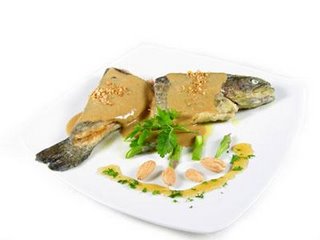 nostia (San Sebastian)... the creme de la creme of Basque holiday seaside destinations. Surprisingly although the entire golden sand beached bay is surround by an ever sprawling town, it still has a blue flag beech.
nostia (San Sebastian)... the creme de la creme of Basque holiday seaside destinations. Surprisingly although the entire golden sand beached bay is surround by an ever sprawling town, it still has a blue flag beech.
Which for those who don't know is the european standard for clean water and a pollution free experience.(Many years before Durango Kafe Antzokia was established) It is said that the recipe itself was invented in 1874 during the siege of Bilbao. A merchant (prior to the siege) had ordered 20,000 pieces of salted bacalao from Scandinavia. Due to a clerical error he was accidentally delivered something in the region of 200,000 pieces.
Before he had a chance to sort out the problem the siege was raised. As food stocks dwindled, pretty much all there was left in the communal larder was olive oil, salted bacalao and garlic. People got pretty inventive and low and behold “bacalao al pil pil”. This is the genuine and only way to make “bacalao al pil pil”, accept no substitutes 8, Pil-Pil is Basque for bubbling, and is onomatopoeic i.e. it sounds like that which it describes.
"Plateruena" is Basque or Euskera for plate maker - we hope you enjoy this plate or dish as would be said in English and the others featured on this recipe site. For we are the platemakers, and we are the eaters of plates!
Basque or Euskera for plate maker - we hope you enjoy this plate or dish as would be said in English and the others featured on this recipe site. For we are the platemakers, and we are the eaters of plates!
Prep Notes: Cut the salted bacalao into 4x4 pieces.To de-salt the bacalao (cod) put it into half a gallon of water, and in the fridge for 2 days. Change the water every 8 hours; at the very least three times… this is essential otherwise it just goes a bit funky.Taste the bacalao (cod), when it has lost most of it’s salt, it is ready. Remove any bones you may find, or alternatively warn the diners that there may be bones.Slice the garlic crossways
Instructions: Fry the garlic until golden in the olive oil, along with the chili and the pimentos (about a quarter of a litre of oil will probably be about right). When the garlic is golden remove from the heat and take-out all solid matter. Put the Garlic and chilies to one side, you have finished with the pimentos so sprinkle them with a little sea salt and eat as a snack while you wait for the oil to cool down.
When the oil is cool enough for you to dip your finger in without pain place the desalted bacalao (cod) with its skin face upwards. Be sure that it does not start to fry.
This is where the funs starts (a.k.a the hard bit). The objective is to keep the oil hot, but not frying, so you need to put a napkin, or cloth on your work top, next to the cooker. Make sure that the heat on the cooker is low. Place the pan on the napkin, and taking it with one hand at twelve o’clock and the other at six, move it around in a circular motion, as if tracing the edge of a circle, not spinning it!!
see the Plateruena "Durango" method in video please click here (9mbs)
This should result in a wave of olive oil running round the pan, and lapping over the top of the bacalao. You can also push the pan forwards and backwards, and change rotation from clockwise to anti clock wise.The aim being to get the oil slopping over the bacalao – don’t wear your best clothes and do wear an apron, as you are quite likely to get a bit aggressive with the pan during the three quarters of an hour or so that it takes to get the end result.
Alternate with putting the pan on the heat and rotating it, and then back on to the cloth. The moment it starts bubbling, take it off the heat urgently, otherwise it will spoil. It is a fine line, too cold is ineffective and too hot a disaster.As time passes you will notice that globs of ‘stuff’ are appearing in the oil, this is the gelatine from the fish, most is in the skin which is why you are trying to bath the skin in the oil. The movement will allow the gelatine and the oil to emulsify, it takes ages… and if you have too much oil to bacalao it takes even longer.
Don’t give up, sooner or later you will notice that the ‘globs’ are starting to turn into a homogenized sauce, at this point return the garlic to the pan. You do not need the garlic to make the pil pil sauce, but it seems a shame to leave it sitting there. Save eight pieces for a garnish when served.You can leave the bacalao to rest (off the heat) for 10 mins or more, and it does quite a bit of the work by itself.
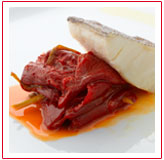
Keep rotating on and off the heat until such time as you have what some people describe as a light mayonnaise consistency sauce, most if not all of the garlic, (if having been thinly enough sliced and goldened properly), should have dissolved, this is part of the magic of the dish. Taste the sauce, if you have soaked the bacalao for a little too long it may require you to add a little sea salt, the dish is intended to be salty – not stupidly so – but too little salt makes for a pretty tasteless serving.If you have problems getting the pil pil sauce to thicken, give it a little more heat, you may be being just a bit too cautious.If the sauce starts to turn into meringue texture, you’ve basically over cooked the bacalao al pil pil..
It is a crime to serve bacalao al pil pil anything other than piping hot, so at the end of the process put it on the heat and keep agitating it until hot all the way through.
Serve with a couple of slices of golden garlic delicately placed on the top of the bacalao.Have a bottle of Tabasco sauce available, and plenty of crusty bread.
Ensalada de bacalao con vinagreta de miel de brezos
Salads
Avec l'arrivée de la chaleur le régime est rempli salades et fruits. La gare offre une grande variété de produits qui sont combinés avec des plaques très faciles à préparer, beaucoup d'eux peuvent être préparés à l'avance. Pain avec tomate, tortillas, viande ou poisson froids, salades, riz, légumes, soupe froide courgette ou tomate. Les desserts favoris sont les fruits de l'été : pastèques, melons, pêches, figues, abricots et poires.
Valencian salade:
1/2 lettuce of choice
segments from one orange
1 small onion, sliced
handful of black olives, halved
dressing of choice
Mix salad ingredients together. Chill in 'fridge for an hour. Either make dressing, using 1/2 dessertspoon lemon juice mixed with 1/2 tsp Herbes de Provence, or use a mixture of fat-free .
INGREDIENTS ( 4 personas)1 lechuga.1 lechuga roja.1 escarola.1 tomate, medio pimiento rojo, medio pimiento verde, medio pepino, 4 rabanitos, 2 cebollas tiernas, 2 huevos duros, 100 g de bonito, 50 g de mojama, aceitunas variadas, pepinillos, anchoas, aceite de oliva y sal.
knives, spoons and forks
knives
The first knives were flint or other rock, chipped or ground to an edge, sometimes with a handle. Used in the Prehistory. Advances in smelting and metallurgy have led to blades made of bronze, iron, then steel and more exotic materals. Both materials and designs have changed over time.
Spoons
Spoons have been used by many cultures since the dawn of time as a vital eating tool. Achaemenid Persian spoon at right illustrates.
From the derivation of the word the earliest northern European spoon would seem to have been a chip or splinter of wood; Greek references point to the early and natural use of shells, such as those that are still used by primitive peoples. Preserved examples of various forms of spoons used by the ancient Egyptians include those composed of ivory, flint, slate and wood; many of them carved with the religious symbols. The spoons of the Greeks and Romans were chiefly made of bronze and silver and the handle usually takes the form of a spike or pointed stem. There are many examples in the British Museum from which the forms of the various types can be ascertained, the chief points of difference being found in the junction of the bowl with the handle.
Medieval spoons for domestic use were commonly made of horn or wood, but brass, pewter, and latten (copper alloy) spoons appear to have been common in about the 15th century. The full descriptions and entries relating to silver spoons in the inventories of the royal and other households point to their special value and rarity. The earliest English reference appears to be in a will of 1259. In the wardrobe accounts of Edward I for the year 1300 some gold and silver spoons marked with the fleur-de-lis, the Paris mark, are mentioned. One of the most interesting medieval spoons is the coronation spoon used in the anointing of the English sovereign.
Forks
It is a commonly believed myth that the table fork was introduced to West during the Middle Ages, as the Romans used forks for serving.
Before the fork was introduced, many Westerners were reliant on the spoon and knife as the only eating utensils. Thus, people would largely eat food with their hands, calling for a common spoon when required. Members of the aristocracy would sometimes be accustomed to manners considered more proper and hold two knives at meals and use them to both cut and transfer food to the mouth. 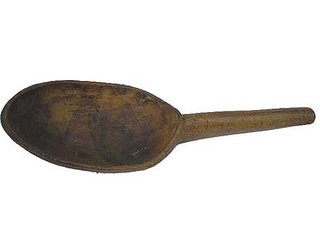
The fork was introduced in the Middle East before the year 1000. The earliest forks usually had only two tines, but those with numerous tines caught on quickly. The tines on these implements were straight, meaning the fork could only be used for spearing food and not for scooping it. The fork allowed meat to be easily held in place while being cut. The fork also allowed one to spike a piece of meat and shake off any undesired excess of sauce or liquid before consuming it. By the 11th century the table fork had made its way to Italy by way of the Byzantine Empire. In Italy it became quite popular by the 14th century, being commonly used for eating by merchant and upper classes by 1600.
It was quite proper for a guest to arrive with their own fork and spoon enclosed in a box called a cadena; this usage was introduced to the French court with Catherine de' Medici's entourage.
Long after the personal table fork had become commonplace in France, at the supper celebrating the marriage of the duc de Chartres to Louis XIV's natural daughter in 1692, the seating was described in the court memoirs of Saint-Simon:"King James having his Queen on his right hand and the King on his left, and each with their cadenas." In Perrault's contemporaneous fairy tale of La Belle au bois dormant (1697), each of the fairies invited for the christening is presented with a splendid cadena.
The fork's arrival in northern Europe was more difficult. Its use was first described in English by Thomas Coryat in a volume of writings on his Italian travels (1611), but for many years it was viewed as an unmanly Italian affectation. Some writers of the Roman Catholic Church expressly disapproved of its use, seeing it as "excessive delicacy": "God in his wisdom has provided man with natural forks — his fingers. Therefore it is an insult to Him to substitute artificial metallic forks for them when eating."[1][2] It was not until the 18th century that the fork became commonly used in Great Britain. It was around this time that the curved fork used today was developed in Germany. The standard four-tine design became current in the early nineteenth century.
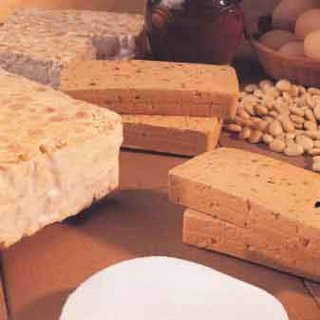
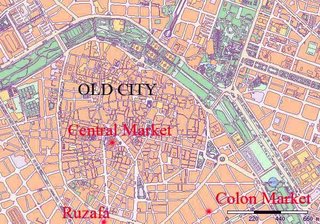 The city was razed to the ground in 75 BC during the war waged between Pompey and Sertorius. Discoveries at a site at La Almoina include the dismembered bodies of various soldiers alongside their weapons, which indicates that a skirmish occurred there. As a result of the conflict, it appears that the settlement was virtually abandoned for at least half a century.
The city was razed to the ground in 75 BC during the war waged between Pompey and Sertorius. Discoveries at a site at La Almoina include the dismembered bodies of various soldiers alongside their weapons, which indicates that a skirmish occurred there. As a result of the conflict, it appears that the settlement was virtually abandoned for at least half a century.